|

 Up
Up 
 Wright Flyer III
Wright Flyer III 
(You are here.)



  Need
to Need
to
find your
bearings?
Try
these
navigation aids:
If
this is your first
visit, please stop by:
Something
to share?
Please:



|
|
Available in Française, Español, Português, Deutsch, Россию,
中文,
日本, and others.
 ver
the winter of 1904-1905, the Wright brothers built a new aircraft,
the Wright Flyer III. Orville first flew this airplane on 23 Jun 1905. Flyer
III had a new airframe and an upgraded engine with slightly larger
cylinders, but it was essentially the same design
and had the same marginal performance and instability as Flyers I and II.
These shortcomings caused a major crash on 14 July 1905 that all but
wrecked the airplane, but from which Orville emerged unscathed. ver
the winter of 1904-1905, the Wright brothers built a new aircraft,
the Wright Flyer III. Orville first flew this airplane on 23 Jun 1905. Flyer
III had a new airframe and an upgraded engine with slightly larger
cylinders, but it was essentially the same design
and had the same marginal performance and instability as Flyers I and II.
These shortcomings caused a major crash on 14 July 1905 that all but
wrecked the airplane, but from which Orville emerged unscathed.
The crash convinced the Wrights to make radical changes to the
aircraft design. They almost
doubled the size of elevator (in front) and rudder (in back) and moved them about twice the distance from the
wings. They added two fixed vertical vanes (called "blinkers") between the
elevators to serve as stabilizers and help prevent the Flyer's tendency to
slip or slide sideways in a turn. They adjusted the rigging to give the wings a very slight dihedral
and counter the airplane's tendency to roll. They disconnected the rudder
control of
the rebuilt Flyer III from the wing warp control -- as they would in all future aircraft
-- placing it on a
separate control handle. (The wing warp -- roll - and rudder --
yaw -- controls had been interconnected in the
1902
Glider, 1903 Flyer I,
and 1904 Flyer II.) On 5 Oct 1905, Wilbur flew 24 miles (38 kilometers) in 39.5 minutes, longer than
the total duration of all the flights of 1903 and 1904. Four days later, they wrote to the
Secretary of War, offering to sell the world's first practical airplane.
Flyer III specifications:
- 40.5 ft (12.3 m) wingspan
- 2-in approx. (5 cm) dihedral
- 6.5 ft (198 cm) chord
- 6 ft (183 cm) separation
- 503 sq ft (46.7 sq. m) wing area
- 1:20 camber
- 83
sq ft (7.7 sq m) double front elevator (referred to by the Wrights as a "horizontal rudder")
- 34.8 sq ft (3.2 sq m) twin movable vertical rear rudders
- 28 ft (8.5 m) overall length
- 780 lb (274.4 kg) total weight (without pilot)
- 4 cylinder engine, 21 hp at 1400 rpm
- Two contra-rotating propellers, 8 ft (244 cm) long, turning
at 490 rpm
The Wrights disassembled the Flyer III on 7 Nov 1905 and stored
it until the spring of 1908 when they adapted it to carry two
people, a pilot and a passenger. They also added a lighter, more
powerful motor and a new control system. They shipped it Kitty Hawk
and on 14 May 1908 made the first passenger flight, taking
their mechanic Charlie Furnas aloft for several rides. Wilbur
crashed the airplane that same day and they abandoned it at Kitty
Hawk, shipping only the engine back to Dayton. The aircraft was
salvaged in 1914, then restored over several years between 1947
and 1950. Today, the restored Flyer III is on display at Wright Hall
in Carillon Park, Dayton, OH. For a detailed inspection of this
historic treasure,
CLICK HERE.
References:
- McFarland, 1953, pp 514, 524, 1190-1192, plates 87-96, 236.
- Wright, Orville in Kelly, 1953, p 46.
- McFarland, Marvin W. (ed) The papers of Wilbur and Orville Wright. McGraw-Hill
Book Co., New York, 1953, pp 514,524, 1190-1192, plates 87-96, 236.
- Wright, Orville, "How We Invented the Airplane." (from depositions in
Montgomery vs. U.S. 13 Jan 20 and 2 Feb 21; in Kelly, Fred C. (editor) How We Invented the
Airplane, an Illustrated History. Dover Publications, New York, 1953, p 46)
[Submitted by Joe W. McDaniel] |
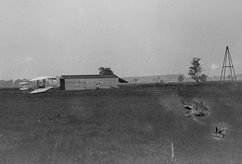
The Wright brothers launched the Flyer III for the first time on 23
June 1905. Note the catapult tower to the right.
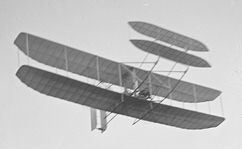
After the Flyer was rebuilt following the crash on 14 July 1905, the
elevator and rudder control surfaces were moved further out from the wings. This made
them more effective and lengthened the response time, both of which
made the aircraft easier to control.
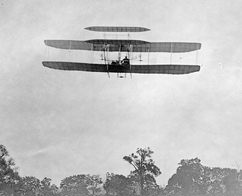
On 29 September 1905, the Flyer III flew fourteen circuits of the
field and landed only when the 1-gallon gas tank was exhausted. The
Wright decided to fit a 3-gallon (11.3 liters) tank to the aircraft.
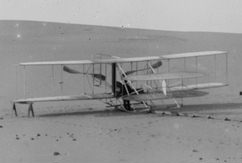
The Flyer III at Kitty Hawk in May 1908. You can just make out the
bench seat for two people.
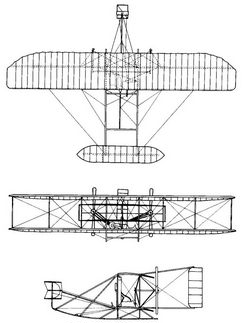
Top, front, and side views of the 1905 Wright Flyer III.
|
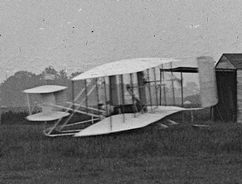
Initially, the elevator and rudder control surfaces of the Flyer III were "close
coupled" -- positioned very close to the wings as on the previous
two Flyers. This made the aircraft difficult to control. The Flyer
III also had two radiators (fore and aft) to prevent the engine from
overheating.
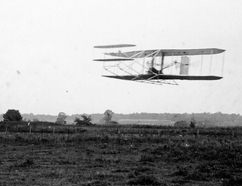
The Wright first tested the rebuilt Flyer on 24 August 1905 and
began to tweak the design. By early September, they were
consistently flying circles and figure-eights. On this flight -- 7
September 1905 -- they hit a bird. It was the first recorded bird
strike in aviation.
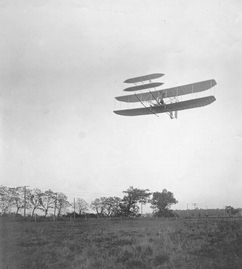
On 3, 4, and 5 October 1905, the Wrights made their first public
flights since May of 1904, inviting friends, reporters, and
upstanding folks they thought would make good witnesses. On 5 October 1905,
Wilbur flew for 39.5 minutes, covering 24 miles (38 kilometers) before
the gasoline in the new 3-gallon (11.3 liters) tank ran out.
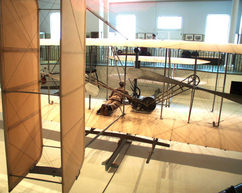
The restored 1905 Wright Flyer III on display at Carillon Park in Dayton, Ohio.
We have collected dozens of additional pictures of this exhibit
HERE.
|